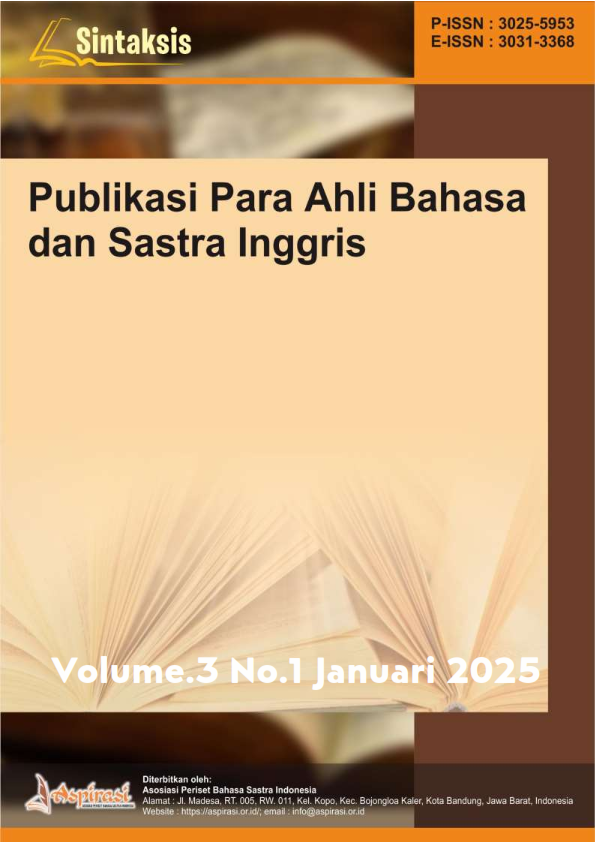Ethical Dimensions of Cross-Cultural Communication : Exploring the NLP Approach in Student Exchange Programs
DOI:
https://doi.org/10.61132/sintaksis.v3i1.1259Keywords:
Neuro-Linguistic, Programming, Mirroring, Rapport, BuildingAbstract
This study investigates the ethical considerations in cross-cultural communication within student exchange programs, focusing on the application of Neuro-Linguistic Programming (NLP) techniques such as mirroring, rapport building, reframing, and anchoring. These methods were analyzed for their effectiveness in enhancing understanding and reducing miscommunication among students from diverse cultural backgrounds. Data was collected using interviews and questionnaires, revealing that NLP strategies facilitated better adaptation, trust, and collaboration. The Findings highlight that students' responses predominantly fell into positive categories, with Strongly Agree (20.67%) and Agree (79.33%), showing a high level of alignment with the statements presented in the questionnaire. Notably, there were no Neutral (0%), Disagree (0%), or Strongly Disagree (0%) responses recorded, indicating unanimous agreement with the ideas conveyed. These results suggest a strong consensus among students, reflecting their shared perspectives and high levels of agreement on the topics discussed. Importance of ethical communication strategies in fostering meaningful intercultural interactions and mutual respect among participants in a multicultural setting.
Downloads
References
Andari, S., Windasari, A. C. S., & Rifqi, A. (2021). Student exchange program of Merdeka Belajar-Kampus Merdeka (MBKM) in COVID-19 pandemic. Jurnal Pendidikan dan Pembelajaran, 8(1). Retrieved from https://www.academia.edu/download/104953560/pdf
Azzahrah Andrianti, R., Hartat, R., Tri Utami, N., Simarmata, N., Syahdani, A., & Hutapea, N. S. (2022). Optimization of digital marketing strategies for micro, small and medium enterprises (MSMEs) snack food products verbal anchoring method in the Gambir Tembung market. Journal of Islamic Studies, 12(2).
Bradley, E. J., & Biedermann, H. (1985). Bandler and Grinder’s neurolinguistic programming: Its historical context and contribution. Psychotherapy, 22(1), 59–62. https://doi.org/10.1037/h0088527
Chen, W.-F., Al-Khatib, K., Stein, B., & Wachsmuth, H. (2021). Controlled neural sentence-level reframing of news articles. https://arxiv.org/abs/2109.04957
Ethics in public relations: Ethical theories, codes and conflicts. (2021). MSAE, 2(2), 82–100. https://doi.org/10.46630/msae.2.2021.07
Fauziah, D. A., & Kuntari, S. (2022). Merdeka Belajar Kampus Merdeka (MBKM): Pemerataan mutu sumber daya manusia pada pendidikan tinggi melalui program pertukaran mahasiswa merdeka. Journal of Social Science Research, 3(2), 2241–2250. Retrieved from http://j-innovative.org/index.php/Innovative/article/view/478
Furduescu, B. (2017). Neuro-linguistic programming: History, conception, fundamentals and objectives. Valahian Journal of Economic Studies, 10(1), 39–50. https://doi.org/10.2478/vjes-2019-0004
Gashi, S. (2024). Enhancing students’ self-confidence in the EFL classroom through neuro-linguistic programming technique - Reframing. Academicus International Scientific Journal, 15(30), 138–152. Retrieved from https://www.ceeol.com/search/article-detail?id=1251215
Ginting, S. A., & Hartati, R. (2023). Neuro-linguistic programming in the English classroom: Perceptions and applications among teachers. Voice of English Language Education Society (VOLES), 7(2), 355–363. https://doi.org/10.29408/veles.22549.v7i2
Hartati, R., Meisuri, S. A., Ginting, S. A., & Ariatna. (2023). Tertiary students’ deficiency in English emphatic listening skills of NLP matching and mirroring technique. SALTeL Journal (Southeast Asia Language Teaching and Learning), 6(2), 1–8. https://doi.org/10.35307/saltel.v6i2.110
Hartati, R., Meisuri, S. A., Ginting, S. A., & Ariatna. (2024). Menguasai komunikasi NLP: Membuka kekuatan soft skill (1st ed.). GETPRESS INDONESIA.
Hartati, R., Meisuri, S. A., Ginting, S. A., & Ariatna. (2024). Utilisation of four pillars NLP technique in studying creative and innovative communication for learning English achievement. Asian Social Science and Humanities Research Journal, 6(1). https://doi.org/
Jahiri, M. L. (2021). Ethical communication in public relations. International Scientific Journal Monte (ISJM), 5(2). https://doi.org/10.33807/monte.20212034
Mishra, S., Khashabi, D., Baral, C., Choi, Y., & Hajishirzi, H. (2022). Reframing instructional prompts to GPTk’s language. https://arxiv.org/abs/2109.07830
Mukherjee, S. (n.d.). “Anchoring” – An NLP master tool. Available at SSRN. https://papers.ssrn.com/sol3/papers.cfm?abstract_id=2191435
Navarretta, C. (2018). Mirroring and prediction of gestures from interlocutor’s behavior. In Topics in intelligent engineering and informatics (pp. 91–107). https://doi.org/10.1007/978-3-319-95996-2_5
Sembiring, A. K., Hartati, R., Syahdani, A., Simarmata, N., Tri Utami, N., & Hutapea, N. S. (2024). Optimizing sales conversion and customer rapport in response to Shopee online shopping app: NLP rapport building techniques. Journal of Innovation Research and Knowledge, 4(4). Retrieved from https://bajangjournal.com/index.php/JIRK/article/view/8571
Sihombing, P. S., & Hartati, R. (n.d.). A neuro-linguistic exploration of mirroring in talk show "The Tonight Show Starring Jimmy Fallon." Retrieved from https://bajangjournal.com/index.php/JCI/article/view/8998
Tosey, P., & Mathison, J. (2010). Neuro-linguistic programming as an innovation in education and teaching. Innovations in Education and Teaching International, 47(3), 317–326. https://doi.org/10.1080/14703297.2010.498183
Vaknin, S. (2008). The Big Book of NLP Techniques: 200+ patterns & strategies of neuro-linguistic programming.
Wikanengsih, W. (2012). Menerapkan neuro-linguistic programming (NLP) dalam pembelajaran. Semantik, 1(1).]
Downloads
Published
How to Cite
Issue
Section
License
Copyright (c) 2024 Sintaksis : Publikasi Para ahli Bahasa dan Sastra Inggris

This work is licensed under a Creative Commons Attribution-ShareAlike 4.0 International License.





